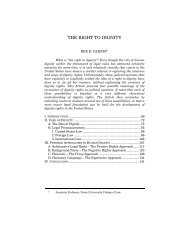A Right to Media? Lorie M. Graham - Columbia Law School
A Right to Media? Lorie M. Graham - Columbia Law School
A Right to Media? Lorie M. Graham - Columbia Law School
You also want an ePaper? Increase the reach of your titles
YUMPU automatically turns print PDFs into web optimized ePapers that Google loves.
2010] A RIGHT TO MEDIA? 437<br />
This right <strong>to</strong> media is centered on the right <strong>to</strong> freedom of<br />
expression and the related right <strong>to</strong> seek and receive information. As<br />
discussed more fully below, the rights <strong>to</strong> freedom of expression and<br />
information have long been recognized as fundamental rights. 22<br />
Because media is the main source of expression and information for<br />
the public, freedom of expression and information applies with<br />
particular force <strong>to</strong> the media. 23 As one regional treaty body notes, “[i]t<br />
is the mass media that make the exercise of freedom of expression<br />
[and information] a reality.” 24 The Special Rapporteur on the<br />
Promotion and Protection of the <strong>Right</strong> <strong>to</strong> Freedom of Opinion and<br />
Expression explains further that “one of the best guarantees of<br />
respect for the rights <strong>to</strong> freedom of expression and information lies in<br />
the existence of independent media, electronic and print, in which<br />
ownership is diversified.” 25<br />
While Article 16 of the UNDRIP appears <strong>to</strong> be an iteration of<br />
the rights of freedom of expression and information, it is<br />
distinguished from these rights as articulated in prior international<br />
documents in that it is formulated from an indigenous perspective.<br />
This is so for the reasons previously noted; these fundamental rights<br />
<strong>to</strong> information and expression have been consistently denied <strong>to</strong><br />
indigenous peoples. One way in which indigenous peoples have been<br />
restricted from exercising these rights has been through their<br />
exclusion in media. That is <strong>to</strong> say that mainstream media sources,<br />
controlled by non-indigenous companies or states, were directed in<br />
such a way as <strong>to</strong> disenfranchise and discriminate against indigenous<br />
peoples, both by denying them a voice in the public domain and by<br />
discussed at the international expert group meeting on indigenous languages)<br />
[hereinafter Legal Framework and Indigenous Languages].<br />
22. See infra Part III. While the right <strong>to</strong> receive information remains<br />
unsettled in some domestic spheres, it is a firmly established right under<br />
international conventional law. See infra note 45 and accompanying text.<br />
23. Article 19: Global Campaign for Free Expression, Note on the<br />
Indonesian Press <strong>Law</strong> 2–3 (2004).<br />
24. Compulsory Membership in an Association Prescribed by <strong>Law</strong> for the<br />
Practice of Journalism (Arts. 13 and 29, American Convention on Human <strong>Right</strong>s),<br />
Advisory Opinion OC-5/85, Inter-Am. Ct. H.R. (Series A) No. 5, para. 34 (1985)<br />
[hereinafter Compulsory Membership].<br />
25. ECOSOC, Comm’n on Human <strong>Right</strong>s, Question of the Human <strong>Right</strong>s of<br />
All Persons Subjected <strong>to</strong> Any Form of Detention or Imprisonment, 17, U.N. Doc.<br />
E/CN.4/1998/40 (Jan. 28, 1998) (prepared by Mr. Abid Hussain) [hereinafter<br />
Human <strong>Right</strong>s During Imprisonment].















